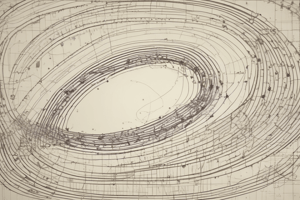Podcast
Questions and Answers
How many points does a line consist of in geometry?
How many points does a line consist of in geometry?
- 2 (correct)
- 1
- 4
- 3
What is the result of dividing any positive whole number by 2, given the original number is even?
What is the result of dividing any positive whole number by 2, given the original number is even?
- An irrational number
- A whole number
- An integer (correct)
- A fraction
How many sides of a triangle share a common endpoint, forming its base?
How many sides of a triangle share a common endpoint, forming its base?
- 1
- 2 (correct)
- 0
- 3
What is the cardinality of a set with 2 elements written as?
What is the cardinality of a set with 2 elements written as?
What is the complement of a set with 2 elements?
What is the complement of a set with 2 elements?
How many truth values can a proposition have?
How many truth values can a proposition have?
What is the result of raising 2 to a positive integer power?
What is the result of raising 2 to a positive integer power?
What is the negation of a proposition with a truth value of true?
What is the negation of a proposition with a truth value of true?
What is the conjunction of two true propositions?
What is the conjunction of two true propositions?
What is the purpose of personal protective equipment (PPE) according to the text?
What is the purpose of personal protective equipment (PPE) according to the text?
What is the function of anti-static devices mentioned in the text?
What is the function of anti-static devices mentioned in the text?
Why is it important to keep cutting tools sharp and in good condition?
Why is it important to keep cutting tools sharp and in good condition?
What should be done if a tool breaks or malfunctions according to the text?
What should be done if a tool breaks or malfunctions according to the text?
What is static electricity as defined in the text?
What is static electricity as defined in the text?
Why should computer technicians and home computer builders guard against static electricity?
Why should computer technicians and home computer builders guard against static electricity?
Which type of tools should be used for a specific job according to the text?
Which type of tools should be used for a specific job according to the text?
What should be done after using a tool according to the text?
What should be done after using a tool according to the text?
Flashcards are hidden until you start studying
Study Notes
Exploring the Number 2: A Journey through Five Perspectives
The number 2 holds a unique place in mathematics and beyond. Let's delve into five facets that make it a fascinating subject:
Topic 1: Arithmetic
Number 2 is the smallest positive whole number. It possesses some distinctive properties:
- Addition: Adding 1 to 2 results in 3.
- Subtraction: Subtracting 1 from 2 yields 1.
- Multiplication: Multiplying 2 by any number results in the original number being added twice.
- Division: Dividing any positive whole number by 2 results in an integer, as long as the original number is even.
Topic 2: Geometry
In geometry, 2 plays a fundamental role:
- Points: A line consists of 2 points.
- Lines: Parallel lines never intersect, forming a distance of 2 or more.
- Planes: A plane consists of 2 lines that are not parallel.
- Angles: A straight line creates two equal angles of 2 right angles (90° each).
- Triangles: A triangle has 2 sides that share a common endpoint, forming its base.
Topic 3: Sets and Relations
In set theory, 2 features prominently in relations and cardinality:
- Relations: A relation consists of 2 sets, one containing ordered pairs.
- Cardinality: The cardinality of a set with 2 elements is written as ℵ₀ (aleph-null).
- Cartesian product: The Cartesian product of two sets results in a new set containing ordered pairs.
- Equality: Two sets are equal if and only if they have the same elements.
- Complement: The complement of a set with 2 elements consists of all elements not in the original set.
Topic 4: Logic and Propositions
Number 2 also has significance in logic:
- Propositions: A proposition can have exactly 2 truth values: true or false.
- Compound propositions: A compound proposition can consist of 2 basic propositions joined by one of the logical operators.
- Negation: The negation of a proposition with a truth value of true results in a truth value of false.
- Conjunction: The conjunction of two true propositions results in a true proposition.
- Disjunction: The disjunction of two true propositions results in a true proposition.
Topic 5: Algebra and Beyond
Number 2 is a basic building block in algebra and other advanced math fields:
- Integer powers: The result of raising 2 to a positive integer power is a positive whole number.
- Binary arithmetic: Binary numbers consist of 2 digits: 0 and 1.
- Squared and cubed: The square of 2 is 4, and the cube of 2 is 8.
- Factors and prime numbers: 2 is a prime number (only factors are 1 and 2).
- Sequences and series: Sequences and series often involve 2 or its powers.
The number 2 is a simple concept, yet it has profound implications in mathematics and beyond. Its fundamental properties have led to a diverse range of applications, from simple arithmetic to complex scientific theories and modern computational systems.
Studying That Suits You
Use AI to generate personalized quizzes and flashcards to suit your learning preferences.




